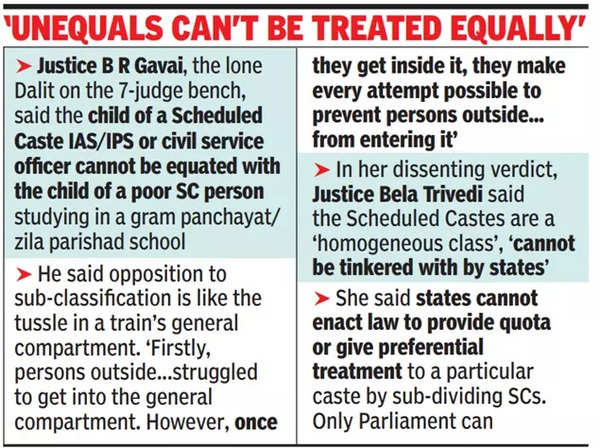[ad_1]
By this 6:1 majority ruling, a bench of Chief Justice D Y Chandrachud and Justices B R Gavai, Vikram Nath, Bela M Trivedi, Pankaj Mit hal, Manoj Misra and S C Sharma overruled the 2004 judgment of a five-judge bench in EV Chinnaiah case which had mentioned SCs had been a homogeneous group and couldn’t be sub-categorised. Justice Trivedi dissented and mentioned the Chinnaiah judgment was constitutionally legitimate.
To minimise politics and govt play over extension of the ‘quota inside quota’ idea to Scheduled Castes, the court docket clarified that sub-classification of castes inside SCs can’t be primarily based on govt’s whims or political issues.
It firmly mentioned sub-classification of probably the most backward among the many SC neighborhood should be primarily based on empirical knowledge, each quantifiable and demonstrable, concerning their backwardness.

Restrict reservation to first technology that avails it & advantages from it: Justice Mithal
The logic behind the court docket’s suggestion for preserving the ‘creamy layer’ out is that kids of civil servants and others from among the many SCs who’ve moved up the socio-economic ladder and obtained good schooling are usually not deserving of quotas. At current, creamy layer exclusion coverage is relevant solely to different backward lessons (OBCs).
The CJI authored a 140-page judgment for himself and Justice Misra. Justices Nath, Mithal and Sharma, via separate opinions, agreed with the opinions of the CJI and Justice Gavai. Each the CJI and Justice Gavai agreed with one another, thus making six of the seven judges concur on the constitutional permissibility of sub-classification of SCs.
It was Justice Gavai, the lone Dalit decide on the bench, who held that these amongst SC/ST communities who have gotten high positions in civil providers and risen excessive in socio-economic strata should get excluded from the reservation scheme for scheduled castes, who had been socially discriminated for hundreds of years.
Justice Mithal took the creamy layer exclusion precept to a special stage. “Reservation, if any, must be restricted just for the primary technology or one technology and if any technology within the household has taken benefit of reservation and has achieved larger standing, the advantage of reservation wouldn’t be logically obtainable to the second technology,” he mentioned.
In his 281-page opinion, Justice Gavai mentioned, “The state should evolve a coverage for figuring out the creamy layer even from the scheduled castes and scheduled tribes in order to exclude them from the advantage of affirmative motion. For my part, solely this and this alone can obtain the true equality as enshrined beneath the Structure.”
Cautioning states that subcategorisation of SCs must be primarily based on empirical knowledge, CJI Chandrachud mentioned, “The place the motion is challenged (earlier than the HC or the SC), the state should justify the premise of its motion. The premise of the sub-classification and the mannequin which has been adopted should be justi fied on the premise of empirical knowledge gathered by the state.”
He additional mentioned, “It can’t merely act on its whims or as a matter of political expediency. The choice of the state is amenable to judicial evaluate… the state should present justification and rationale for its dedication. No state motion will be manifestly arbitrary. It should be primarily based on intelligible differentia which underlie the subclassification. Foundation of the sub-classification should bear an affordable nexus to the thing sought to be achieved.”
Giving an instance, the CJI mentioned if a state decides to supply a special proportion of reservation to ‘dhobi’ and ‘barber’ castes, “it should show that these two castes undergo from differing ranges of social backwardness. It isn’t merely ample for the state to base the classification on the distinction within the conventional occupation of the 2 castes”.
Justice Nath, who agreed with the CJI, mentioned, “I’m additionally in settlement with the opinion of Justice Gavai that ‘creamy layer’ precept can also be relevant to SCs and STs and that the standards for exclusion of creamy layer for the aim of affirmative motion could possibly be completely different from the standards as relevant to OBCs.”
Justice Sharma additionally agreed with the CJI and Justice Gavai.
[ad_2]
Source link
This Submit could comprise copywrite


